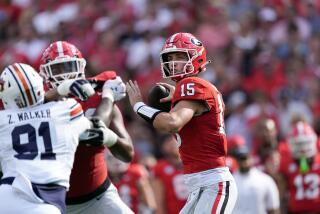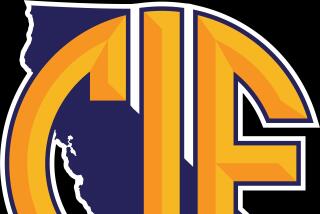Progress Is Most Potent Product
- Share via
A sweeping proposal aimed at restoring confidence in college athletics would, if implemented, empower the NCAA to punish schools whose athletes do not progress academically by banning the schools’ teams from postseason play.
That’s one of several recommendations scheduled to be voted upon today in Denver by an NCAA management council, the first step toward possible approval by the NCAA later this year.
“You get too many kids who come into college and are unable to finish,” said Robert Sloan, president of Baylor University and chairman of the committee that drafted the recommendations. “We are not acting honorably if we bring in young people, use up their eligibility, the scholarship money is gone and they don’t have a degree.”
The committee was made up of 12 university presidents from six major athletic conferences--the Atlantic Coast, Big East, Big Ten, Big 12, Pacific 10 and Southeastern. The group has been working on the recommendations since last summer.
They include proposals to:
* Increase the number of required courses high school athletes need to enter college, from 13 to 16. The committee also wants admissions departments to in turn place greater emphasis on an athlete’s grade-point average and less on SAT and ACT scores.
Said Sloan: “The NCAA’s data shows the GPA in core courses correlates best with [a student’s] academic success in the freshman year in college.” He said an NCAA study shows that a high school student with a 2.5 GPA and 700 SAT score is more likely to graduate college than a student with an 820 SAT and 2.0 GPA. “We propose having a cutoff on GPA at 2.0, but no cutoff score on SAT or ACT.”
* Require athletes to accelerate their progress toward a degree to remain eligible. At present, student-athletes must complete 25% of their degree work by their third year, 50% by the fourth year and 75% by the fifth year--necessary in cases of injury or redshirting. Sloan’s committee seeks to raise those standards to 40% by the third year, 60% by the fourth year and 80% by the fifth year.
* Conduct annual, sport-by-sport evaluations to determine if student-athletes are on track, and maintain a progress and graduation rate consistent with the rest of the school’s student population.
Schools that do not comply would face sanctions ranging from the loss of athletic scholarships to a ban on television appearances or ineligibility for postseason tournaments, Sloan said.
If the committee approves any or all of the recommendations, the full NCAA legislative body would vote on them in October.
Reform in college athletics has been an agenda item for university presidents for several years.
Last June, the Knight Foundation Commission on Intercollegiate Athletics denounced the dismal graduation rates of football and basketball players, the emphasis on television money in football and basketball and the rising influence of commercial entities such as sports shoe and apparel companies. The Knight Commission also recommended punishing institutions that did little to graduate athletes.
Mel Helitzer, a professor of sports administration at Ohio University, is critical of the Knight report and the recommendations of Sloan’s committee, asserting that such proposals are unrealistic.
“It’s an exercise in futility,” Helitzer said. “There is no good reform they can come up with; it’s lip service. We drill these kids on how to shoot baskets. We don’t spend a lot of time giving them geometric proofs.”
But Pac-10 Commissioner Tom Hansen praised the proposed reforms as progress, and predicted they will be approved today and adopted by the NCAA in October.


